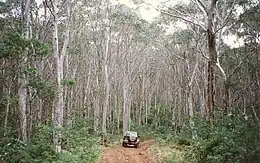Mount Barrington
Mount Barrington,[1] a mountain that is part of the Mount Royal Range, is located on the Barrington Tops plateau in the Mid-Coast Council within New South Wales, Australia and has an elevation of 1,555 metres (5,102 ft) above sea level.
| Mount Barrington | |
|---|---|
| Barrington Volcano | |
 Snow Gums near the summit of Mount Barrington summit | |
| Highest point | |
| Elevation | 1,555 m (5,102 ft) |
| Coordinates | 32°03′S 151°24′E[1] |
| Geography | |
 Mount Barrington Location in New South Wales | |
| Location | Barrington Tops National Park, New South Wales, Australia |
| Parent range | Mount Royal Range |
| Geology | |
| Age of rock | Eocene[2] |
| Mountain type | Shield volcano |
Now the remnants of a volcano, Mount Barrington, formerly the Barrington Volcano, erupted near its present peak between 44 and 54 million years ago. The eruption caused a 700-cubic-kilometre (170 cu mi) basalt flow, which covered much of the Barrington Tops plateau. The lava was up to 1,000 metres (3,300 ft) thick.
The extensive rainforests in the area grow on much of the resultant red/brown soils.[2][3] Gemstones such as zircon, sapphire, sapphirine and ruby were formed from the volcano.[4] Nearby Careys Peak is considered a vent in this extinct shield volcano. The surrounding area is covered by sub alpine Snow Gum woodland, with rainforest on the escarpment edge and in fire free gullies.
References
- "Mount Barrington". Geographical Names Register (GNR) of NSW. Geographical Names Board of New South Wales. Retrieved 11 May 2015.
- Johnson, Robert Wallace; Knutson, Jan; Taylor, Stuart Ross (1989). Intraplate Volcanism: In Eastern Australia and New Zealand. Cambridge University Press. p. 123. ISBN 978-0-521-38083-6.
- Adam, Paul (1987). New South Wales Rainforests: The Nomination for the World Heritage List. p. 78. ISBN 978-0-7305-2075-7.
- Sutherland, F. L.; Fanning, C. M. (2001). "Gem‐bearing basaltic volcanism. Barrington, New South Wales: Cenozoic evolution, based on basalt K–Ar ages and zircon fission track and U–Pb isotope dating". Australian Journal of Earth Sciences. 48 (2): 221–237. doi:10.1046/j.1440-0952.2001.00851.x. S2CID 129043286.